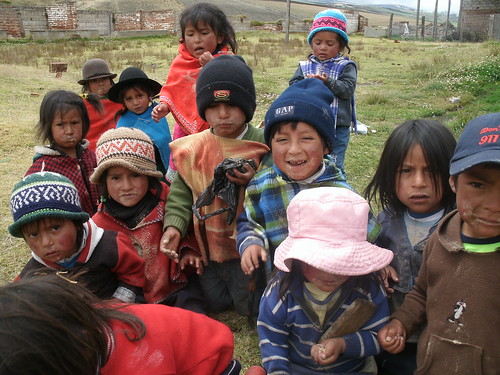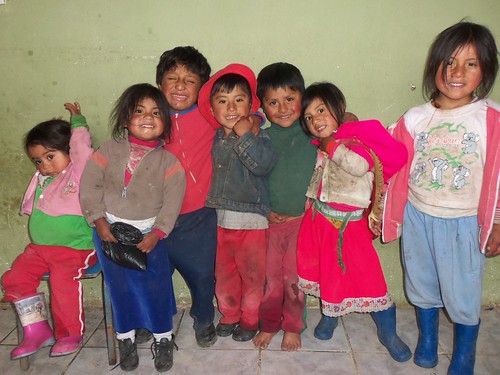Recently I've been doing some reading during my down time at the clinic, and I came across a really interesting report from the World Bank published in 2007 called "Nutritional Failure in Ecuador." Guess what its about?
 |
| The main gang from La Merced in all their "Lord of the Flies" glory. Seriously, its chaos there. |
To be fair, Peace Corps gave me the report on a CD after the food security conference I attended back in December, but that CD was loaded with stuff and only recently have I attempted to sort through the readings. There are hundreds. The title of this particular report caught my eye, because they're not usually that blunt. Indeed, it details the policy and program failures of the various health and education programs in Ecuador dealing with nutrition. I think that I've explained a little bit about the issues here, but this report does such a wonderful job of outlining the problems, that I just had to share it. Even though it was written 5 years ago, I think that the vast majority of the conclusions still are true today.
First, the general profile of nutrition in Ecuador:
- Stunting of children under 5 is the main nutritional problem in the country.
- The prevalence of stunting varies greatly by socioeconomic group and by geographic location. Stunting is highest in rural areas, in the mountains (or Sierra), among indigenous populations, in poor families. Which is to say, exactly who I'm working with.
- Like in other countries, almost all stunting is produced within the first two years of life.
- There is probably a huge micronutrient deficiency problem, but the data is really old.
- Children's nutritional states worsen markedly during the first year of life, and then remain stable. The critical window of opportunity for interventions to prevent stunting is during pregnancy and in the first year of a child's life. ---> In my experience, the primary reasons for a lack of growth in the first year of life are an overall lack of hygiene, lack of knowledge of best feedings practices (particularly when the first foods are introduced), the common use of unpurified water, and frequent occurrences of diarrhea and respiratory infections (the #1 killers of kids under 5).
- The height of the mother is an important determinant of the child's nutritional status. Every Ecuadorian girl rescued from stunting now, reduces the likelihood of a future child being born stunted.
- The mother's expectation regarding her child's height is highly relevant to stunting outcomes. Other things being equal, women who did not realize that their child was too small at birth are more likely to have a stunted child today. Counseling at the community level to improve nutritional knowledge should be a main plank of nutrition strategy. ---> You'd be shocked at how common it is for parents to say that their baby is "just small". Parents of small babies seem to feed them less, the justification being that since they are small, they don't need as much food. This is a very persistent belief and its difficult to convince people otherwise.
- Children in urban areas have much better growth prospects than rural children. Nutrition strategy should concentrate on rural communities.
- Altitude has a strong, negative association with nutritional status. Nutrition strategy should give high priority to the isolated communities of the Sierra. ---> Mountain dwelling people are known to be smaller all over the world, (because of a lack of oxygen and availability of nutritious foods? I'm not totally sure) but on top of that, kids are too small.
- Household's resources are an important determinant, but offer a "long route" to improved nutrition outcomes. Other more direct strategies to improve nutrition are needed to complement income growth. ---> There are two welfare programs I'm more or less knowledgeable about: one is for families in the lowest two-fifths income brackets and is a $35 grant every month. The other is for pregnant mothers and kids under 1 year of age and is $10 every other month. That grant is small and supposed to cover the costs of transportation for moms to get to the clinic every month for a checkup. The idea is that at these monthly checkups, the doctor will counsel the mother in best practices if the child is under weight or height. In theory, awesome idea. In practice, uhh... sure, something like that happens.
- Stunting is positively correlated with the number of household members and the number of preschool children in the household. Adequate birth spacing and reduced family size are relevant strategies for improving nutritional outcomes. ---> In my interviews, I found that the average number of kids per family was 3.3. However, the kids typically come rapid fire, one every 10-18 months, far less than the recommended 2 years a mother's body needs to recover and recuperate nutritionally.
- The availability of toilets has a positive impact on nutritional status. Investments in rural sanitation are likely to yield positive returns in nutritional status. ---> I was so excited to read this! Just another reason to push for this dry latrine project, and another factoid I can use to justify the project when I ask organizations for funding.
- Once the model is fully specified, ethnicity does not appear as a statistically significant factor causing stunting. The stunting observed in indigenous communities results from their location, socioeconomic exclusion, behavioral factors, and policy failure in overcoming these problems--not from genetics.
Ecuador has a variety of feeding programs through the Ministry of Health and the Ministry of Education, but they are pretty sporadically implemented throughout the country. The World Bank report goes into each of these programs extensively, which was great for me to understand more thoroughly what the heck is going on here, but is probably not super interesting for you.
The one program I do what to highlight is the Ley de Maternidad Gratuita or LMG (Free Maternity Law), a law passed in 1999 that promotes access to free primary health care and medicines for pregnant women and kids under 5. It's a fantastic idea. However, silly me, I thought that since the word "law" is in the title, it meant that it was actually that. A law. Enforceable. How wrong I was. (I probably should not get into the details of this because it has to do with government organizations much, much bigger than me, so suffice it to say that when even the tiniest amount of bureaucracy is involved, "laws" go out the window and its every man, or in this case, clinic, for himself. When I asked the director of my clinic why we haven't had medicine for moms and kids for the last month, he replied that the law is more of a "theory".)
The last part of the report I want to share are the recommendations:
- Improve programmatic coordination in the nutrition sector under the Ministry of Health. They've got so many programs doing so many things, and there are lots of repetitions and some significant oversights.
- An important piece of Ecuador's nutrition strategy is community-level counseling, linked to growth monitoring. I don't know why this is such a difficult idea to grasp, but I believe it is THE MOST important thing Ecuador could do to improve nutrition in the Sierra. Individualized, frequent community counseling with growth monitoring would do wonders. It just doesn't exist now. Well, it does sporadically, but to be effective it needs to be consistent. Giving a single 1-hour talk to moms every three to six months will not make a difference (especially for women who maybe have a year or two of primary school and can barely read or write), and it is endlessly infuriating to me that the people I work with don't seem to get that.
- Program assignments should be adjusted based on the severity of the regional situation. Duh.
- Transparency and accountability at the program level should be given high importance. Pretty important to keep track of where the money's going and whether it's making any difference.
- Make main welfare grant linked to nutrition outcomes.
- Figure out the micronutrient policy! This is one thing that Ecuador is trying and retrying to get right because apparently they just recently figured out that micronutrients are super important to growth and development (you know, vitamins and minerals). The problem with the current policy is that its all over the place, and no one ever quite knows whats going on. First, they came out with a nutritional supplement for kids under 5 called Mi Papilla, or my baby food. Then they threw that out the window (I'm not sure why) and now they've got Chispaz, or sprinkles, which as far as I can figure is the same thing. They're little packets of powdered vitamins that providers are supposed to add to specific kinds of food once a day. I guess moms couldn't figure it out, so they've made it the responsibility of the day care centers. But ask the cooks to explain to you how they're supposed to prepare the food and add Chispaz, and you get shy giggles and "I don't remember." Hopefully they're doing it correctly in practice and just unable to explain it.
 |
| A few of my little homies from Chalaguan, posing for the 8 millionth picture, which was followed by many minutes of insane giggling. |
Lastly, I made another tastier-than-average soup this evening for dinner (merienda) which included garlic, carrots, onions, lots of broccoli, veggie stock, quinoa, and pesto. I'm now officially ready to declare that pesto is good with anything. Go on, tell your friends.
